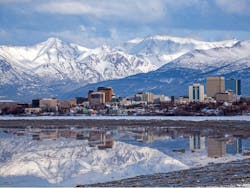Traditionally dependent on an oil economy, Alaska is looking to renewables and microgrids to generate wealth, cut energy costs, boost resilience and transition away from fossil fuels.
The Port of Alaska, Homer Electric and others are developing new microgrids or upgrading existing fossil-fueled microgrids with renewables and storage.
“As a state, Alaska is facing the reality of a world transitioning away from our primary export [oil] and economic foundation,” said Rob Roys, chief innovation officer at Launch Alaska, which aims to mitigate the effects of climate change.
Some rural communities pay as much as $1.80 per kWh for grid power, he said. The grid is made up of a series of mostly fossil-fuel-based microgrids operated by rural utilities. The utilities pay high prices to keep natural gas plants running to provide “spinning reserves” – backup power in case the grid experiences a blip or goes down.
By adding renewables, controls and storage to their systems, the communities can avoid keeping fossil fuel plants running, saving thousands of dollars a day in one case and allowing for energy independence.
Danger of food shortages
But high costs aren’t the only challenge the communities and rural utilities face. Outages can create safety and food security challenges — especially for the Port of Alaska, the state’s only port, which supplies food and goods to the US Department of Defense and 90% of the state’s residents, said Jim Jager, director of business continuity and external affairs and facility security officer for the Port of Alaska. He’s planning a microgrid to provide resilience and lower costs.
The port, whose load swings from 1.5 MW to 7 MW and includes demand from a nearby military base, Joint Base Elmendorf-Richardson, wants to use a microgrid to level the demand to a steady 2.5 MW. The port also wants to cut fossil fuel use and provide resilience during outages that pose critical risks to the port, the military base and the residents of Alaska. The microgrid would include solar – about 2.5 MW to 3.5 MW – storage and a nearby backup generator owned by a local utility.
An outage at Port of Alaska can cause food shortages, according to Jager. Ninety-five percent of the food sold in Alaska has to be brought into the state. Food and goods are brought in containers that are moved by cranes that need electricity to operate.
“We have a small market spread out over a huge area at the end of a long supply chain. If something happens to break the supply chain, we have six to 10 days and then are out of food,” Jager said.
Learn more about microgrids in Alaska during a discussion, “What Remote Microgrids Can Teach Us All about the Future of Energy,” at Microgrid 2022 in Philadelphia on June 2. Register for the two-day conference.
In addition, the US Department of Defense relies on the port to be operational. The Port of Alaska is one of 18 Department of Defense seaports, and all of the fuel needed for the defense department to patrol northern borders comes through the port. About 20% of the goods that pass through the port are for the Department of Defense, said Jager.
With the proposed microgrid, Jager wants to address safety and economic issues for the port. For example, if an outage occurs when there’s an incoming tide and the port is using an electric crane to offload containers, the crane might get tangled up in the ship if the tide is high.
But more important – a possibility that keeps Jager up at night – is the risk of Alaska’s entire “railbelt grid” going down. The grid is about the size of a small midwestern utility’s and extends over 500 miles, traveling over mountain ranges and glaciers. The grid relies on natural gas, and a gas shortage could cause an outage.
“We need a backup that keeps the grid functioning,” he said.
A microgrid with storage could help level the load and reduce demand charges. And it could allow the port to isolate from the local utility, Chugach Electric, during an outage.
What stands in the way of more microgrids
But the port faces regulatory and economic challenges to getting a microgrid deployed.
State regulations prevent the port from aggregating its tenants’ meters. Those tenants include a cement mixing operation with high peak loads. Right now, the tenants have their own separate meters. But Jager wants to aggregate the meters so that he has a big-picture view of demand and then offer incentives for tenants to cut their usage during peak hours.
“We need a mechanism to aggregate the port’s loads and incentivize each individual player to use power more efficiently when other people aren’t using their power,” he said.
In addition, Jager wants the microgrid to pay for itself. That would involve “harvesting” the benefits and allocating them appropriately. The port could possibly get federal grants for the project, but, as a municipal agency, it can’t take advantage of tax credits. Bringing in a third party that could take advantage of tax credits is one option, he said.
Jager doesn’t want to be in charge of operating the battery so Chugach Electric or another player could possibly do that, he said.
“The good news is that it’s all doable,” he said.
Augmenting the “small and sketchy” grid
Homer is one of five electric cooperatives that make up the “small and sketchy” Alaskan grid, he said. The cooperatives each have their own generation, and each carries a little more capacity than what’s needed at all times. Homer Electric has this extra capacity available from two combined-cycle natural gas plants and a hydropower facility.
In 2019, the utility had to island from the main grid for five months because of wildfires, which meant that it was isolated from the main grid and had to operate its own spinning reserves.
“We had to provide our own spinning reserves, 45 MW. If one unit tripped, the other two could ramp up,” Thomas said. But that means the utility was running two combustion turbines instead of one, which was inefficient. In fact, it cost $1,000 an hour of additional fuel usage for five months.
“When islanded we use a lot more fuel to provide spinning reserves but a battery can sit there charged and ready to jump in,” said Thomas.
The utility now has a Tesla Megapack that provides 46.5 MW, which cost $41 million and “saves the day” during outages by helping the utility avoid the extra costs of natural gas. It also helps Homer Electric integrate renewables. The battery can fill in when there’s a cloud cover.
“We will make the money back when there’s an outage,” said Thomas.
200+ independent microgrids in Alaska
Meanwhile, Alaska has more than 200 remote power systems, most of them diesel-based, said Roys. They’re all independent microgrids. At least 20 have installed storage, and some have added renewable energy, including Shungnak, a 9.6-square-mile community of about 300 people in a region where temperatures can drop to 40 below zero.
The Shungnak community now relies less on diesel by using a 225-kW solar array and a 384-kWh battery system. A microgrid controller with a “diesels off” function allows for automatic coordination between the solar and energy storage as well as communication with the diesel plant about the best times to turn off the diesel.
Such projects are helping Alaska move away from oil and invest in renewables, which represent a wealth creation opportunity for the state, said CEO of Launch Alaska Issac Vanderburg in the organization’s 2020 annual report.
“That’s because Alaska’s unique geography, history, natural resources and our decades of experience as an energy state positions us well to be a leader, not a victim, of the global energy transition,” he said.









